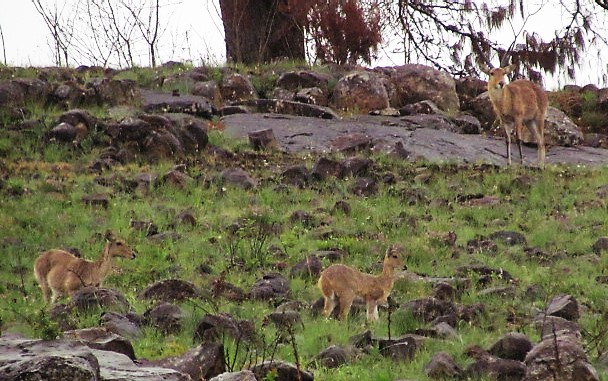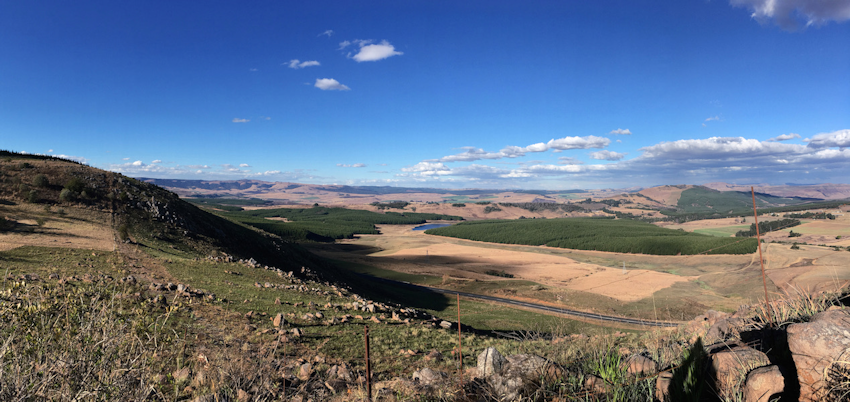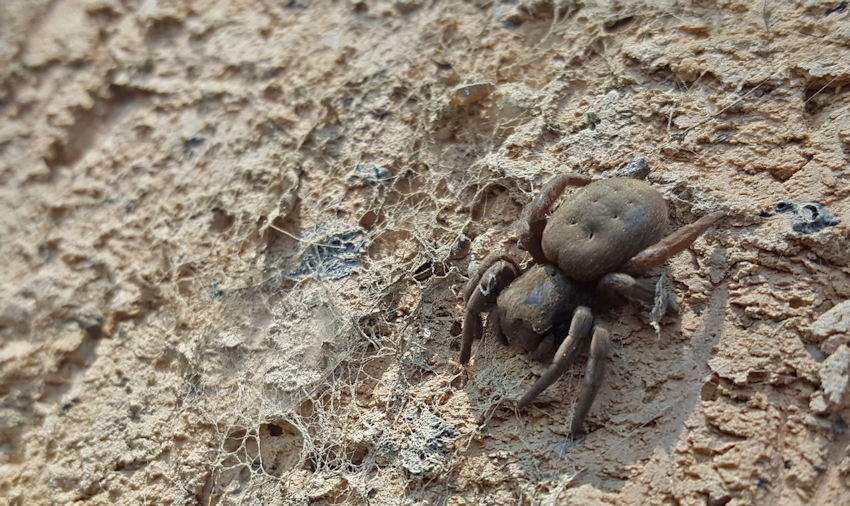Wildlife Sightings - September 2017
The Dargle Conservancy publishes stories, pictures, and comments, which our members send to us each month, mostly as received by us, and with minimal editing on our part. We cannot guarantee the correctness of any information contained in reported sightings, nor do they necessarily reflect our views or opinions.
Please send your contributions to us, and feel free to comment on the sightings, or to ask any question by sending an e-mail to us here. Pictures should be at least 850px wide.
Gilly Robartes - Wanna Farm
The Herald snakes seem to be out and about in the Midlands. Gilly Robartes captured this beauty.

Herald snake
Pat and Sandra Merrick - Albury Farm – Lidgetton
I would just like to thank Christeen and Chrystelle for showing their lovely photos in the Dargle newsletter this month. I was getting despondent about the lack of photos each month but this month was certainly a bumper crop of photos. Thanks to all those who contributed.
This has been a month of extremes – hot, cold and windy – and at times, all on the same day. Thats the Midlands. Our stream dried up and our dam is still empty. We have had light rain and I thank the good Lord for that. May we all get good hard rain in October.
Most of my photos have been taken through the mist and drizzle, so some bedraggled looking birds.

Bedraggled Drakensberg Prinia
And the coats of the reedbuck matted and ruffled.

Male, female and baby reedbuck on a cold drizzly day
The last time we saw four oribi was on the 4th September.
The same day we had two Herald snakes sliding between the flowers in the rockery looking for skinks (lizards).

Herald snake
It was a hot day and the African Harrier Hawk was also trying his luck by landing in the shrubs now displaying their new growth of spring leaves and flowers.

African Harrier Hawk
Two pairs of White-throated Swallows also arrived and sat awhile under the eaves to cool off.
At 4pm the next day when Pat was fixing the borehole, the dogs chased a jackal. A few days later when Pat was down at the borehole at 8.30am I happened to see a jackal running up the side fence inside our garden. This has never happened before as we have bonnex fencing to keep out the duikers and porcupines. Fortunately my dogs weren’t around but what had happened was that Pat had left the gate open and this jackal lost his way and came through into our garden (pic). There must be little food around for them to be hunting during the day now. When Pat came home he went looking for the jackal but it must have gone back through the open gate as nowhere to be seen thank goodness.

Jackal
We have also had the odd male vervet monkey coming into our veggie garden to eat the lemons.
Pat saw a pair of Stanleys Bustards flying over the farm. We had a trailcam for a few weeks and picked up two porcupines, a duiker, genet and a Black-bellied Korhaan (Bustard?) walked in front of the camera one morning.
The owls are back under the eaves on top of the verandah roof. They have two owlets who have been flying for the past ten days and set off the security alarm at least once a night. The adults are feeding them on top of a wooden archway into my veggie garden and also on a ledge in the front porch. We can see this by the regurgitated food and white poop. I am hoping that there are pictures of them on the cam camera as we did not have time to check it out.

Barn Owlet
Ten days ago two Wagtail chicks were born in the jasmine hedge. During this time it was drizzling and cold and a few days later they died. Undeterred, the adults decided to make another nest, and guess where they chose? Yes back on the verandah in the same pot plant as last year. That ended in disaster when I found the dead chicks on the ground beneath the nest one morning. So I changed the pot plant and put another one in its place but that didn’t change things at all. They took just 2 days to make a lovely nest with sticks and grass and another 2 days to line it with feathers. Most of the feathers come from the owlets I think. It is now completed and I am waiting for the first egg to be laid. I have noticed when it is wet and cold that they stay away from the nest.

Wagtail nesting in potplant
Another exciting visit on the 23rd September was our pair of Lesser Striped Swallows that nested in our courtyard last year and reared three chicks. They seemed tired and it was another cold drizzly day and they sat on the courtyard door for a few hours. I have only seen them when its miserable weather and then they come and perch on the hanging basket for a few hours normally late afternoon. No sign of a nest yet.

Lesser Striped Swallow pair
There are a number of birds in the garden now as the waratahs, giant proteas and strelitzias are flowering which has drawn a lot of the Sunbirds back.

Male malachite sunbird eating from waratah flowers

Female Amythest Sunbird
The Olive Thrushes enjoy bathing in the rock pools no matter what the weather.

Olive Thrush
The tails of the male Widowbirds are now starting to lengthen. A group of about 20 visit the garden each day.

Widowbird
The pair of Blue Cranes are still eating from the cattle feed tyres otherwise see them in the kikuyu lands. They sleep on the neighbouring farm where there are two dams and will probably nest there if we don’t get rain soon to fill our dam.

Blue Crane pair
Other sightings:
Southern Boubou

Male Pin-tailed Whydah

White-eye on strelitzia flower

Eriosema distinctum – beauty out of ashes
Kathryn Coulson - New Forest Farm
Disconcertingly, I had a fair sized rinkhals sunning himself on the deck the other day. Went to fetch my camera and the movement of the wooden floor spooked him.
I did capture this lovely moth though.
 rs.png)
Unidentified moth
Christeen Grant - Sitamani, Boston.
On the 1st of September the light and air clarity was exceptional!

The first half of September was bone dry with hot berg winds, the exposed ground started to crackle open in fine lines. However the second half has seen quite a few damp days, with some light rain bringing relief to the vegetation. The evening of the Spring Equinox, 22 September showed promise of moisture, and there have been several misty days.
The 16 September brought a delightful discovery of a ‘new’, first observation, this orchid is Eulophia parviflora (short-spurred form). Found near Impendle, KZN at ±1500m on a dolerite ridge. I first noticed the buds on 27-08-2017.
Today 16-09-2017 there were fully mature (but not 'opened') flowers, plus flowers still opening. The inflorescences are ±300mm tall. The leaves were only at the base of the more mature flowering inflorescences. The mature flowers were covered in small black ants. This is the first time I've observed this orchid flowering here.
 IMG_9720.JPG)
Eulophia parviflora
 IMG_9944 850.png)
Eulophia parviflora
 IMG_9943 850.png)
Eulophia parviflora
Craig Peter (Associate Professor, Botany, at Rhodes University Grahamstown remarks that they are unusual as they are pollinated by flower chafer beetles, which are attracted by the lovely scent.
Many flowers have appeared small and stunted, like Aster bakerianus, however there have been some lovely flowers including:

Asclepias stellifera

Dierama sp. possibly cooperi

Eriosema salignum

Eriosema kraussianum

Gladiolus longicollis, evening flowering, pollinated by Hawk Moths

Moraea graminicola

Raphionacme hirsuta

the unremarkable Senecio discodregeanus with flowers and seeds

Tulbaghia leucantha, Highland Wild Garlic, a member of the Onion family and the leaves can be used as a herb in cooking

and a tiny, dainty Vernonia sp..
The birdsong morning and evening has been an absolute delight as they busily court each other and forage. At the beginning of September the male Black-headed Oriole was in full courtship display!

Black-headed Oriole
I finally managed to photograph one of the pair of resident Fork-tailed Drongos.

Fork-tailed Drongo
Although ubiquitous I have a very soft spot for the pair of Hadeda Ibis that frequent the garden and surrounds.

Hadeda Ibis
I also saw a Cardinal Woodpecker pecking in the shrubbery, a Cape Batis, a pair of African Hoopoes in the orchard and a Long-crested Eagle consuming a Vlei Rat near the house. The Village Weavers have not started building nests as early as last year.
While sitting quietly on the hillside one evening I saw a male rock agama soaking up the warmth of a rock between last season’s grass stalks.

Southern rock agama
Insects have started to be more apparent. Groups of young grasshopper hoppers scatter quickly when I’m walking in the new green grass. A few butterflies have flitted about including a Painted Lady, Vanessa cardui.

Vanessa cardui
Moths are gradually reappearing, including the delightful daytime flying African humming bird moth, not the greatest photos, very difficult to catch them static as they flit quickly from flower to flower.

African hummingbird moth
Others seen were:

Cherry spot moth

Hutchinson's shark moth - Cucullia hutchinsoni

possibly an emperor moth sp.

and a Related Lappet, Leipoxais peraffinis.
Normally hover flies are also difficult to photograph, but this hover fly, Allograta fuscotibialis sat still for a short while…

Hover fly - Allograta fuscotibialis
Crystelle Wilson - Gramarye
Bok-bok! Ma-kierie-kierie! And spring has duly been announced.

Bokmakierie
Also in full voice was a Levaillant’s Cisticola at the dam on Elandshoek

Levaillant’s Cisticola
The brood of South African Shelducks are growing up fast – already they are looking like young adults.

South African Shelducks
A Three-banded Plover was on its continuous patrol of the water’s edge

Three-banded Plover
Looking at geese outside the water, one can’t help but notice that their legs were made for walking

Egyptian Goose

Spur-winged Goose
But another ground-dweller, the African Pipit, does have the ability to perch on a wire, unlike the geese

African Pipit
The Grey Crowned Cranes, which mate for life, renewed their vows at the beginning of a new breeding season, while the Wattled Cranes were a study in symmetry. Their youngster was no longer around, they must have introduced it into a floater flock of cranes where it hopefully will find a mate of its own.

Grey Crowned Cranes

Wattled Cranes
The Yellow Bishop looked decidedly dishevelled in the midst of growing his breeding outfit

Yellow Bishop
A small flock of Cape Canaries enjoyed seeds that were on offer.

Cape Canaries
A Southern Double-collared Sunbird had a sip of nectar and a Cape Robin-Chat found a tasty morsel in the garden.

Southern Double-collared Sunbird

Cape Robin-Chat
Ashley Crookes - Copperleigh Farm
This month I saw some really interesting things, especially the small stuff which we so often miss. From spiders to ants and worms, sometimes we just need to look at what is right next to or below us, rather than trying to find all the large wildlife around us.

Velvet spider - family Eresidae

Rinkals found dead on the road
We also had some great rain on Copperleigh Farm over 4 & 5 October, nearly 50mm, so I'm waiting patiently for the grass to grow and the dam to fill after struggling for the past 2 years with the drought. Hopefully we will have a normal rainy season this year.

After nearly 50mm of rain over 4 & 5 Oct there were lots of very large earthworms appearing all over the area

Very large ants

After two years of drought, some dried streams and springs are starting to flow again.

Wildflowers are starting to return to the dry and burnt grassland.
We also had a Reedbuck eating in our oat field one morning. The Secretary bird has been around quite a bit recently, and on one very misty day it came crashing down on our roof and was in the garden for a bit before the dogs upset it.

Secretarybird
The Helmeted guinea fowl have also made a return after a few years, and we even had one on the paving right outside the front door!

Helmeted Guineafowl
Other sightings:

A pair of Blue Cranes

Always sad to find sightings such as this dead Midlands dwarf chameleon found on the road.

Barn Owl

Dead rat - a meal left over sitting on one of the fence posts

Baby scrub hare that was caught in the fires of a grass management burn
Jenny Fly - Kildargh
I noticed this fungus growing on an old tree stump. It looked like solidified foam . Such a startling color.

Jenny also sent this photo of Scadoxus puniceus - for more information on this plant click here.

Scadoxus puniceus

